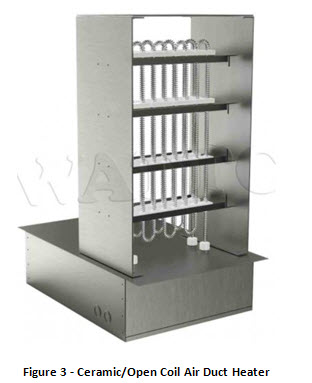Air Duct Heaters
Last updated on April 1st, 2019 at 02:48 pm
It’s common to install air ducts on the roof of industrial and commercial areas and buildings. Those primary uses for air ducts are the following: central air heating, ventilation and air conditioning. For a large building or structure, supplement heating is necessary to deliver the air at appropriate quality and temperature.
Duct heaters are ideal to warm low-pressure air flow via convection heating. For cold and humid environments, the air flowing temperature of the duct will gradually decrease across the duct wall. For this case, an air duct heater would be useful to supply the required heat in order to warm the building. A duct heater’s simple design and installation is the main feature for this product.
In addition, duct heaters have a large variety of application; for example, comfort heating, humidity control, freeze protection, heat treating, air pre-heating, etc. For large buildings and houses application, the primary use of air duct heaters is air ventilation system and comfort heating. A unit heater or a ceramic heater can be installed during or after the new building construction since this type of air heater can be easily removed and installed.
Duct Heater Design
The design of the desired duct heater is totally based on the target application. Custom air duct heaters have the following selections: voltages, finned/unfinned tubular or coil elements, configuration type and orientation. WATTCO™’s technicians will ensure that the final product would perfectly fit to the target air duct.
An air duct heater possesses multiple heating elements that are either coils or tubes that are attached to a steel casing, which is mainly used to prevent vibration and to protect the heater. Incoloy® unfinned tubes (Figure 1) are the most common selection due to its simple and energy saver design. Finned tubes (Figure 1) are generally good for additional protection, especially for humid air ducts from electrical shock. Open coil element is an alternative for heating large air surface area and it requires less energy to operate.
Duct Heater Types
Various types of air duct heaters are manufactured in order to support the latest and current available air duct technologies. A popular selection is the slip-into design (Figure 2). The slip-into air duct heater inserts in the middle of the air flowing ventilation duct. This particular type of heater can be inserted or displaced,so it’s sometimes known as the unit heater. Unit heaters are efficient for house and commercial buildings since its simple design makes it easier to remove for maintenance and cleaning.
No matter how strong the air duct wall insulation is, there are still heat losses in the air flow. In humid and cold environment, the unit heater can also provide freeze protection since it prevents air condensation or deposition inside the air duct. Therefore, duct heaters can deliver complete or supplementary heating for lengthy distance and large surface area air duct.
Alternative Design
An alternative design would be the ceramic heater which is useful for precise and intermediate air heating applications. Ceramic heaters are different from the tubular heating elements since they possess open coil with ceramic elements (Figure 3). The main feature of ceramic materials is its insulation property. Using ceramic heating elements has two main advantages, the first is that a ceramic heater saves energy by lowering the natural heat losses (by the ceramic’s insulation) and the second benefit is that ceramics reduce the chance of fire risk.
Because of the ceramics’ insulation property, the open coil elements would generate a uniform heat distribution constantly even for large surface area duct. Ceramic heaters are particularly good to use for large buildings and structures since the duct heater promotes the air flow efficiency and additional safety factors.  At the same time as to providing the necessary heating, duct heaters can also be used for dehumidification. High indoor humidity is a problem which causes microorganisms like mold to grow. inside a building. This can lead to potential damaging on the property’s structural integrity. If these microorganisms become airborne, they could also affect the health of the property’s occupants. By simply installing an air duct heater (either a unit heater or ceramic heater) does not only offer the heating solution but also eliminate the air moisture and quality issues as well.
At the same time as to providing the necessary heating, duct heaters can also be used for dehumidification. High indoor humidity is a problem which causes microorganisms like mold to grow. inside a building. This can lead to potential damaging on the property’s structural integrity. If these microorganisms become airborne, they could also affect the health of the property’s occupants. By simply installing an air duct heater (either a unit heater or ceramic heater) does not only offer the heating solution but also eliminate the air moisture and quality issues as well.
WATTCO™’s duct heaters are customized to fit most of the present air duct system designs. If you have any questions about how WATTCO™ air duct heaters would improve your ventilation system, please contact our technical representatives for assessing the opportunities.
Reference
United States. U.S. Department of Energy. Energy Efficiency and Renewable Energy. Better Duct Systems for Home Heating and Cooling. National Renewable Energy Laboratory, Nov. 2004. Web. 30 Dec. 2011. <http://www.nrel.gov/docs/fy05osti/30506.pdf>


